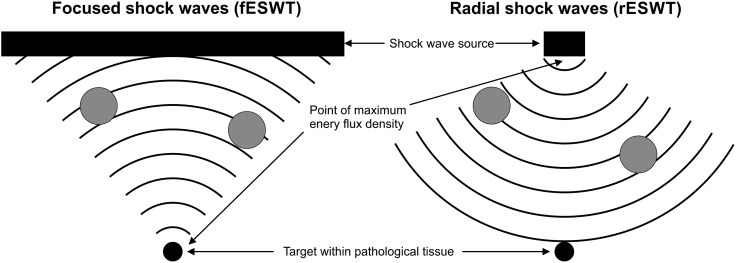Fig. 1.
Working principle of focused and radial extracorporeal shock wave technology. In case of focused shock waves, single acoustic pulses are generated either with a spark-gap (electrohydraulic principle), a technology similar to a loudspeaker (electromagnetic principle) or piezocrystals (piezoelectric principle) (details are provided in Fig. 2). By means of reflectors of certain shape, the acoustic pulses are converted into a focused acoustic pressure wave/shock wave with a point of highest pressure at the desired target within pathological tissue. In case of radial shock waves, a projectile is fired within a guiding tube that strikes a metal applicator placed on the skin. The projectile generates stress waves in the applicator that transmit pressure waves into tissue. It is of note that any disturbance in the pathway of the acoustic pulses between a focused shock wave source and the target within tissue (such as bone, calcifications, etc.; grey dots in the figures) may result in some parts of the acoustic pulse not reaching the target and, thus, weakening the shock wave energy (i.e. the energy flux density) at the target. The same disturbances would not impact the energy of radial shock waves at the target. This is most probably the reason why in muscle tissue, the energy of focused shock waves was found to be decreased by >50% compared with measurements in water, whereas for radial shock waves, measurements in muscle tissue and water were consistent.11

